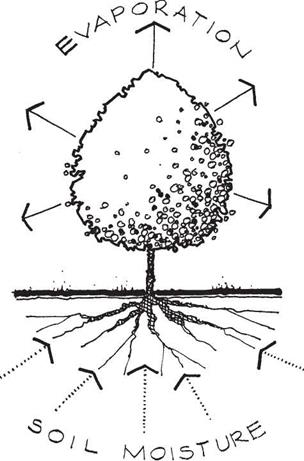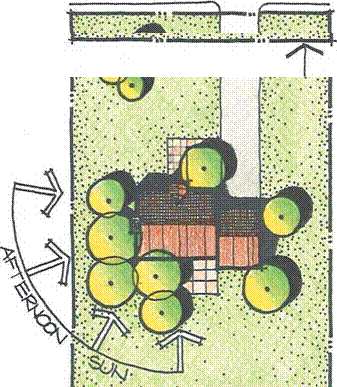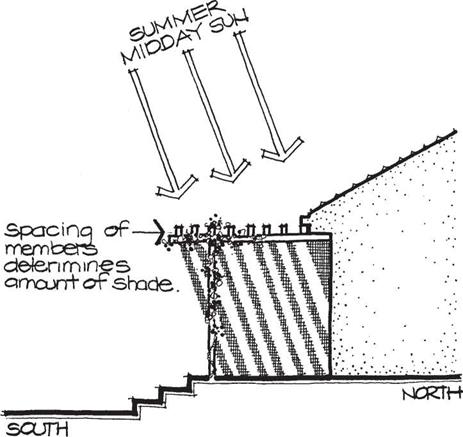 |
 |
Second, shade trees provide relief from hot air temperatures through evapotranspiration, a process of giving off moisture through leaf surfaces. Moisture is taken from the ground by a plant’s roots, moves through its trunk and branch structure, and is released through the plant’s leaf surfaces (Figure 3—18). As this moisture evaporates from the leaf surfaces, it simultaneously cools adjoining air temperatures. It has been estimated that a large shade tree can evaporate as much as 100 gallons of moisture per day, thus giving the cooling effect of five air conditioners.[4]
To provide shade, trees should primarily be located on the southwest and west sides of the house and outdoor spaces (Figure 3—19). Shade trees can be placed in other locations as well to accomplish other design objectives, such as creating spatial edges or controlling views. Still, the densest grouping of trees for shade should be placed to the southwest of areas that need shade. The best type of tree for shade is one that is relatively tall, broad, and densely foliated. A broad or wide tree canopy will cast more shade than a tree that is more upright or fastigiate.
Where possible, shade trees should be located over or as close as possible to the structure or outdoor space that is to be shaded because of the high summer sun angle previously described. A 25-foot-high tree located 10 feet from the west wall of a house may shade 47 percent of the surface while the same tree placed 20 feet from the wall will only shade about 27 percent of the surface.[5] One exception to this guideline is for
 |
 |
regions that experience severe fire hazard (see “Protect from Potential Wildfires” in “Natural Events and Cycles” in this chapter).
Vines and shrubs can also be used to shade the residence. Vines can be grown on exterior masonry walls of a house to shield the exterior wall surface from absorbing the sun’s rays and converting them to heat, as discussed earlier. A mass of shrubs planted along an exterior wall will have a similar effect. These techniques are most effective on exterior walls that face either east or west because of the lower sun angle from these directions (Figure 3—20). Vine-covered or shrub-screened exterior walls are less useful on a south-facing wall because of the higher sun angle from this direction.
The provision of shade can have notable benefits. Houses that are shaded may have interior air temperatures up to 20°F lower and have uncomfortable internal air temperatures half the time as long as houses that are not shaded.[6] This translates to reducing the need for air conditioning and the associated electric bill. Similarly, an air conditioner located in the shade operates 10 percent more efficiently than an air conditioner in direct sun.[7] Overall, a shaded house is simply more energy efficient than one that is not. Similarly, outdoor spaces that are shaded by large trees are cooler than those in the direct sunlight. Areas below trees may be 5 to 10°F cooler than nearby areas in direct sun. Shade makes outdoor spaces more comfortable to use for longer periods of time during the summer.

Overhead structures such as arbors, awnings, and pergolas can likewise be used to provide shade for outdoor spaces used during the summer months. These structures can stand alone or be attached to the house as an architectural extension. Vines may also be grown over and through overhead structures to soften their architectural character and to provide additional shade and cooling. One advantage of awnings and structures in comparison to trees is that awnings and structures provide shade immediately after construction. Shade trees may take years to grow large enough to provide effective shade.
Awnings and overhead structures are most effective in providing shade from the midday and early afternoon sun when the sun angle is high. Awnings and overhead structures are less useful for early morning and late afternoon/evening sun because of the lower angle of the sun at these times of day. Thus awnings and overhead structures are best located directly over or slightly to the south or west of outdoor spaces to be shaded (Figure 3—21).
A number of variables need to be considered when designing overhead structures. One is the density and pattern of the overhead members that cast shade. An awning or solid rooflike overhead plane provides the most shade and is most useful over an outdoor space that is used extensively from midday through midafternoon. However, a solid overhead plane can create a dark space below and may increase air temperatures by creating a cap that holds in the heat.
It is often better to create an overhead structure with multiple individual members spaced apart. The space between the individual members allows for heat to rise and escape through the overhead plane, thus helping to keep the space cooler. The size and spacing of the individual members has a direct effect on the amount of shade cast. Large and/or closely spaced members provide the most shade, whereas small and/or widely spaced members cast less shade. The amount of shade desired will depend on the use of the space, the regional location, and the time of day when shade is needed. The density and pattern also have a bearing on the visual shade pattern cast on the
 |
 |
ground plane. The shadow pattern on the ground plane can itself be an attractive quality in an outdoor space.
Another consideration for creating overhead structures is the direction of the overhead members. This, too, should be based on the amount of shade required. Density aside, more shade will be cast by individual members that are oriented perpendicular to the direction of the sun (Figure 3—22). Consequently, individual members should be placed in an east-west direction to cast effective shade from a southern sun at midday, whereas a north-south direction is more effective when the sun is shining from the west, as occurs from mid – to later afternoon in the summer. The angle of the individual members should also be considered. Members that are placed at right angles in relation to the sun’s rays will provide more shade than members that are positioned parallel to the sun’s rays.
Walls and fences also produce sun protection. These vertical planes are most effective in providing shade in the early to midmorning and from midafternoon to evening during the summer season. During these hours of the day, the sun angle is lower, and sunlight is more directly blocked by a vertical plane than an overhead plane. Therefore, walls and fences are best located to the east and/or west of the spaces that are to be shaded. These same elements are also effective in casting shade onto the west wall of a house to relieve a residence from the intense heat buildup in this microclimate. As with overhead structures, there are numerous design variables available to create a wide range of shade density.



